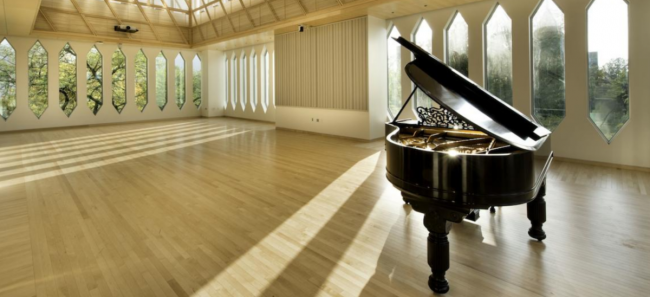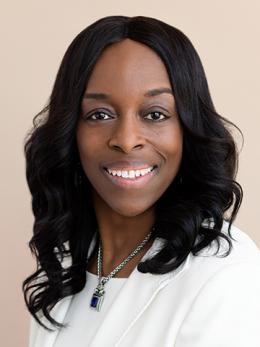You have /5 articles left.
Sign up for a free account or log in.

A studio at Oberlin Conservatory
Oberlin College
Facing challenging finances and a demographic cliff, Ohio's Oberlin College is mulling a strategic plan that would trim 100 students from its renowned music conservatory while adding the same number to its liberal arts program.
The shift, which would take place slowly, over four years, would bring the conservatory’s enrollment to around 480. It would also create a brand-new minor in music for liberal arts students, who often show up with musical interests but little interest in a music career. Oberlin would offer these students conservatory classes and private lessons, as well as the opportunity to perform with conservatory students.
College officials say the moves would make the conservatory more competitive. For one thing, they would technically shrink it, offering fewer slots for top musicians. They would also allow Oberlin to capture musically inclined students who nonetheless want to major in the liberal arts -- the college’s data on recently admitted applicants to the liberal arts program show that nearly 80 percent of applicants who list music performance as a field of primary or secondary interest end up enrolling elsewhere, despite the presence of the acclaimed conservatory on the same campus.
The changes are aimed at “ensuring Oberlin’s long-term resiliency” in an uncertain time for both liberal arts colleges and music conservatories, said President Carmen Twillie Ambar.
Oberlin predicts that the shift would also bring in millions more in revenue. As recently as 2017, the liberal arts program saw net revenues of $23.9 million, while the conservatory lost $11.1 million.
That’s not because of different tuition rates -- the two programs are priced identically, college officials said. But conservatory students bring in about $10,000 less, on average, since the two schools are in search of different pools of students. To be competitive among other conservatories, Oberlin must offer these prospective students more aid than it does liberal arts students, who are enrolled in what's officially known as Oberlin's Arts & Sciences program.
Officials predict the change could produce an estimated $1 million in new revenues annually, beginning in year four of the plan.
The change would need approval by Oberlin's Board of Trustees, which is expected to vote on it at its June meeting.
"If this is how you keep financial aid intact, and you continue to work on the most important initiatives you have going on, then maybe it's the right thing to do." -- alumna Linda Holmes ('93)
In an interview, Ambar said many “extremely talented” musicians don’t choose the conservatory because they don’t see themselves performing professionally. “We haven’t captured enough of those students because we can’t give them enough access to the conservatory to enhance those abilities,” she said. Doing that won’t dilute the quality of instruction -- even the student musicians say that “hasn’t been a concern that they’ve expressed” during the process.
“Yes, our conservatory’s students perform at an extremely high level -- they’re entering the profession, absolutely. But there is a nice, robust group of Arts & Sciences students who will be able to mesh with those students in ways that will enhance this experience.”
Perhaps not surprisingly, alumni say they hate to see the conservatory shrink, but they see both sides of the debate.
Linda Holmes, a 1993 liberal arts graduate who hosts NPR's Pop Culture Happy Hour, said she hasn't followed Oberlin's financial travails closely enough to second-guess "people who have put this kind of work into coming up with recommendations." But she said she'd be sad to see the conservatory -- and the number of people who each year earn degrees there -- shrink. "At the same time, it always gives me comfort that everything that happens at Oberlin is argued over endlessly, to the point where if there are other options to prevent this, they'll be brought to the forefront."
Holmes, whose first novel appears in June, said she "loved being on a campus that was shared with a music school. It enriched my life so much to know musicians -- some of my close friends were either conservatory students or double degree. I don't relish any reduction in the size of the conservatory. But I also don't relish seeing the school struggle in the long term. If this is how you keep financial aid intact, and you continue to work on the most important initiatives you have going on, then maybe it's the right thing to do. But I trust them to fight it out. That's kind of classic Oberlin."
Ziya Smallens, 2016 liberal arts graduate who works as a political speechwriter with West Wing Writers in New York City, similarly said he is weighing the proposal's pros and cons. An amateur musician himself, he recalled applying for a conservatory class that required passing a vocal skills test. He balked at the test and never took the class. As painful as that was, he thinks Oberlin was correct to demand top-notch musical skills. "It would have been lovely" to take the class, he said, "but those opportunities should not come at the cost of preventing would-be musicians from entering the conservatory."
Terry Hsieh, a Beijing-based multi-instrumentalist who earned bachelor's degrees in Chinese and jazz performance at Oberlin in 2012, said he hadn't seen the proposal. But he said he hopes Oberlin “can continue to leverage its strength in the higher ed world: producing both talented and creative liberal arts and sciences graduates and professional-level musicians who make a sustained impact in the world of music.”
Needed: More Revenue
Like many other small private colleges, Oberlin faces challenging financial times ahead. In addition to structural deficits that could last several years if unaddressed, Ambar said, Oberlin is confronting the reality of smaller numbers of high school graduates in the Northeast that puts it at a distinct disadvantage, since unlike many larger colleges, it primarily serves traditional-age students.
The extra revenue from more liberal arts students can’t come fast enough. Last June, the board approved a $160 million budget that included a projected $4.7 million deficit. Without making cuts, the college’s deficit could have been as high as $9 million this year, an "unsustainable" figure that would hamper Oberlin's ability to offer financial aid "and to invest in our faculty, staff and campus," college officials said in an open letter to campus.
Ambar, along with Chris Canavan, Oberlin’s board chair, and Chesley Maddox-Dorsey, the vice chair, said the college last year raised enrollment. "But we’ve also had to contribute more financial aid, so the net revenue gain from improved enrollment has been modest. In other words, we are exhausting our pricing power," they wrote.
For new students, fall 2019 tuition and fees, along with room and board, are expected to be $73,694.
Raising tuition, they said, "only increases the demand for financial aid. It also adds to the financial strains on our students and their families, making it harder for us to keep them at Oberlin from the day they matriculate to the day they graduate. This weighs heavily on Oberlin’s finances."
The college has said that if it doesn’t trim expenses, Oberlin’s deficit could reach $162 million within a decade. It relies on net student income for 83 percent of operating revenue.
In its most recent audited financial statement, Oberlin said 97 employees took voluntary buyouts in 2016, with another 17 in 2018. It reported $184 million of outstanding bonded debt.
With an $887.4 million endowment last year, 186-year-old Oberlin is wealthier than most small private institutions, but far behind its wealthier peers -- colleges like Amherst, Swarthmore and Wellesley all reported endowments at or near $2 billion. For the past few years, Oberlin has drawn about 5 percent of its endowment for operating expenses, a standard distribution. Last year, that amounted to about $44.1 million.
In a widely circulated October 2017 letter, Canavan, the board chair, said a group of trustees examining the college’s finances concluded that “we lean too heavily on cash from generosity (past and present gifts, and borrowing against future gifts) and not enough on cash from operations (tuition, room and board).”
He said Oberlin has many generous donors. “But they’re not generous enough to insulate us from the ups and downs of enrollment and retention, or from the broader socioeconomic trends that make it harder for families to afford Oberlin. The conclusion may seem self-evident, but it’s important nevertheless: we can’t stop appealing to generous donors, we need to find ways to boost our operating revenues and we have to reduce our cash needs where possible.”
Oberlin remains selective, said Ambar, but it’s “still facing those same headwinds” as other liberal arts colleges.
Looking back over the past decade, the conservatory’s application numbers peaked in 2017, with 1,396 applications, up from a low of 1,189 in 2014. Last year, 1,256 prospective students applied. Of those, 33 percent were admitted, up slightly from 28 percent in 2017.
The New England Conservatory of Music in Boston had a slightly higher acceptance rate at 33 percent in 2017, according to the most recent federal data. At the Juilliard School in New York City, just 6 percent of applicants were admitted in 2017, federal data show.
While last fall’s enrolled conservatory students had higher average SAT scores than in recent years, Oberlin’s liberal arts students had mixed scores.
Oberlin's selectivity in the college of liberal arts has dropped slightly: in 2018, it admitted 39 percent of applicants. As recently as 2016, its acceptance rate stood at just 29 percent.
By way of comparison, Amherst College admitted just 13 percent of applicants in 2017. Middlebury last year admitted about 19 percent. Carleton College in Minnesota admitted about 20 percent, an admissions official said.
“To say that they’re being prepared just to show up to be the first violinist in the Chicago Symphony Orchestra is a very narrow view of what their career path will be.” -- Oberlin president Carmen Twillie Ambar
Oberlin's yield, in both the conservatory and the college of liberal arts, has shrunk: the conservatory enrolled 42 percent of admitted students in 2009. Last year, that dropped to 33 percent. In the college of liberal arts, yield dropped from 32 percent to 29 percent. Enrollment last fall totaled 2,785, about what it was a decade earlier.
C. Todd Jones, president of the Association of Independent Colleges and Universities of Ohio (AICUO), said he was impressed with how the college is going about the strategic process. “The beauty of what Oberlin is doing here is addressing the problem before it becomes a crisis. And that’s leadership,” he said.
It's clear that college officials have looked at the conservatory "in the context of the whole operation" and are trying to "make adjustments that are true to the overall mission of the institution, while looking at the dollars and cents of how it operates."
Officials foresee conservatory faculty, facing smaller enrollments, being freed up to offer “greater and more meaningful musical experiences” to liberal arts students -- collaborating with faculty across campus in interdisciplinary performances, for instance.
David Kamitsuka, dean of the liberal arts college, said the goal is to provide a more integrated experience that connects classroom work with experiential learning, likely in the form of more internships. Students come to Oberlin because they’re interested in a classical education, he said, “but they want pathways for that classical education to launch them into meaningful lives.”
William Quillen, the conservatory’s acting dean, said, “Every conservatory is having this conversation.” The realities of being a professional musician are “completely different from the world of 2010 or 2000, let alone 1980,” he said. “What we offer them in 2020 has to be different -- and will invariably, and must be different, from what we offered them 10, 20, 30, 40 years ago.”
While today’s conservatory graduates must play their instruments with the same technical mastery as always -- and with broad knowledge of classical repertoire -- they must also be able to perform in other musical styles and in different settings such as in film, animation and videogame soundtracks. “And on top of that, they have to have an entrepreneurial disposition,” he said, a set of skills that musicians simply didn’t need a generation ago.
“They’re being asked to do radically different work,” Ambar said. “To say that they’re being prepared just to show up to be the first violinist in the Chicago Symphony Orchestra is a very narrow view of what their career path will be.”
She said conservatories “have to be prepared for an industry that’s changing more rapidly than health care has changed. What it will look like we don’t know, but we think we’re on the right track in helping our students prepare for the unknown.”
A Way to Differentiate Itself
Among other proposals, Oberlin is considering shrinking the size of its campus to save on utility costs and deferred maintenance, as well as introducing new majors such as business and global health.
AICUO's Jones said he can't recall another instance in which he has seen “a deeper engagement of various stakeholders, while simultaneously being very public about numbers and about the effects of policies. I just don’t see that very often with processes like these at campuses.”
He's not surprised that's taking place at Oberlin, a college known for inclusivity. Founded in 1833, it was coeducational from the beginning and began admitting African American students two years later.
The open process is “true to the culture of the place,” Jones said. “I’m looking forward to the results of it, because colleges learn from each other. And the experience here, if it’s successful -- and I expect it to be so -- it is one that’s likely to be drawn upon by other institutions going forward.”
Michael Emerson Dirda, a 2009 graduate who majored in English and history, said many students choose Oberlin because "while they may not be conservatory-caliber musicians themselves, they still love playing music, learning about music and being surrounded by music. If the enrollment changes are able to free up resources for such students and otherwise bridge the gap between college and conservatory, this could be a useful way for Oberlin to differentiate itself from similar liberal arts institutions."
NPR's Holmes, who is also a former attorney, said she's more concerned about what seems a bid by Oberlin to reconsider hourly workers' pay. "That worries me a little," she said.
The college says that while many faculty salaries fall below those of peer institutions, Oberlin's hourly workers earn "significantly higher wages than their counterparts" at four nearby liberal arts colleges. Oberlin’s average hourly staff wage is 34 percent higher than at Kenyon, Denison, Ohio Wesleyan and Wooster Colleges.
"I don't want to see the school in a race to the bottom with hourly wages -- although again, I feel weird second-guessing, because they've put some study into this, and it's not like they're likely to be leaving chests full of money they could just open up and empty out," Holmes said. "It's just hard. It's painful. Oberlin for me was weird and intense and serious and sometimes kind of aggravating, but there's nothing quite like it. I think that's probably still the case, even as they tackle this."




